
Cupping Therapy Page Menu: 1 2 3 4 5 Next>>
Cupping Therapy During the Golden Age of Piracy, Page 3
Illnesses Treated By Cupping Therapy
Illnesses Treated By Cupping Therapy - Those More Commonly Treated
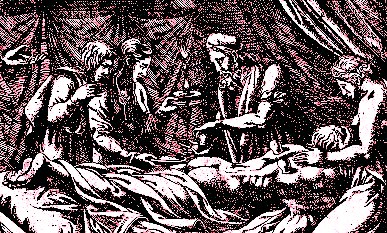
Artist: Diana Ghisi
A Cupping Scene, From the Wellcome Museum, London (16th century)
While each surgical author during the golden age of piracy had a disease or two that only they recommended cupping therapy
be used for, several medical issues had broader support from surgeons during the golden age of piracy. These are the diseases which were most likely treated with cupping therapy at this time. They included: arterial and veinal wounds, burns, eye problems, head wounds, poisoned wounds, tumors and venereal buboes (or swellings).
Let's look at how cupping therapy was used to treat each of these.
Illnesses Treated By Cupping Therapy - Arterial and Veinal Wounds
Three of the authors who wrote for surgeons going to sea recommended the use of cupping therapy in treating wounds of the veins and arteries, establishing cupping as a practice for such by sea-going doctors.
Sea surgeon John Woodall explains that "wounds in the veines and Arteries, bring with them commonly a fluxe of bloud, which to stay [stop] is a speciall businesse." He provides
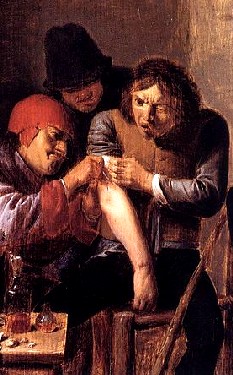
Artist: Adriaen Brouwer
Feeling (Bleeding) (1635)
three treatment suggestions for stemming the blood flow: medicines to contract a bleeding orifice, ligature or tying off broken veins and arteries, and caustics to burn the end of the vessel closed. Woodall adds that "phlebotomie, the use of cupping glasses and ligature on the parts [of the body] opposite [to cause blood to flow to the constricted location]."1 Note that he uses revulsion to draw the "bad" blood a fairly large distance away from the site of the wound.
It seems unusual to bleed a patient who has just been bleeding from a vein or artery, something Woodall comments upon. He says that such methods are "not alwayes to be presumed upon as safe courses, but upon neede, if so be the veine or artery wounded be great many things are of force put in practise, which otherwise seeme very harsh."2
Sea and military surgeon Richard Wiseman likewise advises revulsive cupping in addition to other humor diversion techniques once a vein or artery has been closed. "You may also let the Patient blood, by opening a Vein on the contrary part, if his strength will permit it, taking a little at a time only for Revulsion. You may use also Cupping, Friction, and Binding the remote Parts, for Derivation."3
Note that Wiseman appears to use slightly different terminology than we have established, referring to wet and dry cupping to move humors as 'derivation' to the opposite (and thus remote) side of the body while calling bloodletting in the same location revulsion. You may recall that on the previous page, we established the term 'derivation' to mean moving humors to a different location near to the where they are presently and 'revulsion' to refer to moving humors to a place more distant. It is not unusual to find such variations in terminology at this time as the language was not used as precisely as we expect today, but we can infer Wiseman's meaning from the context of his statement.
1,2 John Woodall, the surgions mate, p. 132 3 Richard Wiseman, Eight Chirurgicall Treatises, 3rd Edition, p. 345
Illnesses Treated By Cupping Therapy - Burns
Two authors detail how they used cupping glasses for burns, one for a wound accompanied by a burn and another for the burn itself.
During a fight at sea, military surgeon Richard Wiseman explains how an Irish sailor's gun accidentally fired while he was ramming his bullet down the barrel due to glowing embers stuck in the honeycombed wall of the weapon.

Artist: Thomas Luny
Ship Afire Battle of the Nile (1834)
The gun "shot the Rammer out of his hand, tearing the Palm of his hand, also some of his Thumb and Fingers. The Wound was not considerable, but the force of the Blow extinguished both sense and motion of the Member."1
Wiseman cured the resulting wounds, noting that once it had healed, "I made him a Fontanel [a wound kept open by an irritant to encourage the formation of pus] in that Arm, and bathed the member frequently, also cupped and scarified it; and afterwards applied Plaisters of Pitch, to stir up a heat in the Members."2
Fellow military surgeon William Fabry reported that "paine followeth [burns], by reason of the solution [separation] of continuity and sudden mutation which violently draweth humors and blood from the body."3 Fabry applied medicines to protect the skin while it healed along with bandages wet in water and vinegar to prevent the bad humors from gathering at the site of the burn.
He also suggested a variety of treatments to prevent the humors from gathering at the burned skin including "blood-letting, cupping, and other revulsions, that the humours and blood may be drawne and evacuated to the other part"4. (Although he uses the term 'revulsion' when discussing his treatment, it is not entirely clear from his comments whether he advised dry cupping revulsion or wet cupping here.)
1,2 Richard Wiseman, Eight Chirurgicall Treatises, 3rd Edition, p. 427; 3,4 Guliielm. Fabritius Hildanus aka William Fabry, His Experiments in Chyrurgerie, p. 19
Illnesses Treated By Cupping Therapy - Eye Damage
Several authors mention cupping therapy in relation to wounds of the eye. Ambroise Paré explained that patients with both internal and external damage to the eyes could be treated by bloodletting from the cephalic vein (in the arm) in addition to "cupping glasses and horns [of animals used as a cupping vessel] [which] must be applied to the nape of the neck and shoulders"1.

Artist: Thomas Luny
Cupping, From Princely Court Library, Waldeck Arolsen (1622)
For patients with Ophthalmia, or inflammation of the eye, Richard Wiseman recommended derivation using a variety of methods including cupping. He said that "if there be Inflammation, or that Blood abound, [the surgeon] may bleed by Lancet in the Arm, Neck, &c. otherwise by Leeches behind the Ears, Shaving the Head, Blistering, Cupping, Fontanels and Setons [issues made by irritating a wound with foreign objects inserted into the skin]"2.
Sea surgeon John Woodall warned that "wounds of the eies are dangerous by reason of their affinity as well with the Pericranium as the other Membrans of the braine"3. As a result, such wounds are painful, "wherefore by glister [clysters - enemas], bloud letting, cupping glasses, purgations [emetics - medicines to cause vomiting] and sober diet the accidents are to bee staied [stopped]"4.
It is notable that none of these authors recommend cupping therapy alone for treating wounds of the eyes; rather they use it as one of the several therapies to move or remove ill humors.
1 Ambroise Paré, The Workes of that Famous Chirurgion Ambrose Parey, p. 145; 2 Richard Wiseman, Eight Chirurgicall Treatises, 3rd Edition, p. 308; 3,4 John Woodall, the surgions mate, p. 138
Illnesses Treated By Cupping Therapy - Head Wounds
For wounds to the head surgeons often employed cupping glasses to divert humors. While treating a sailor who had been struck in the head with a cutlass, naval physician Hugh Ryder treated a resulting delirium by bloodletting. He explains that he took "eight ounces of Blood next day out of the right Arm, and cupping Glasses were applied to his Neck, and Shoulders"1.
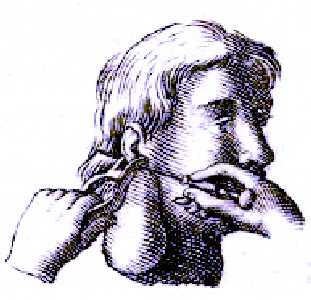
Inserting a Seton Below the Ear,
From L'Arcenal
de Chirurgie, by Jacques Guillemeau, p. 152 (1655)
Richard Wiseman recommended bleeding "In all Hurts of the Head, what sort soever they be of", particularly for people of 'ill habit of body' who had an 'abundance' of bad humors. As is typical for Wiseman, he included "Cupping (with or without Scarification) of the Neck and Shoulders" amongst a laundry list of other humoral techniques including: bleeding, application of a fontanel [an irritant such as silk threaded into the skin to encourage pus to form] under the ear and emetic purging medicines.2 Wiseman later details a head wound case in which "Cupping with Scarification was made", although it is just one of several humor diversion techniques he uses in that case.3
Sea surgeon John Moyle only makes limited use of cupping in his surgical manual, but he particularly calls for it when "there be a depression of the Scull" without an accompanying cranial fracture. In this case, he tells the surgeon to "apply a Cupping-Glass, with great Flame, and pull it up forcibly"4. This is a particularly interesting use of the cupping glass because, unlike the other authors, Moyle is not using it to move humors. Instead, he is attempting to use the glass to pull the unbroken, depressed skull up so that it is not pressing on the brain. .
1 Hugh Ryder, New Practical Observations in Surgery Containing Divers Remarkable Cases and Cures, p. 5; 2 Richard Wiseman, Eight Chirurgicall Treatises, 3rd Edition, p. 382; 3 Wiseman, ibid.; 4 John Moyle, The Sea Chirurgeon, 4th ed., 1702, p. 110
Illnesses Treated By Cupping Therapy - Poisoned Wounds
"They [cupping glasses] are also applied to such as are bit by venomous beasts... so to draw the poison from within outwards." (Ambroise Paré, The Workes of that Famous Chirurgion Ambrose Parey, p. 443)
Based on the number of surgeons who recommend it for their treatment, poisoned wounds are the most widely supported health problems for cupping therapy.
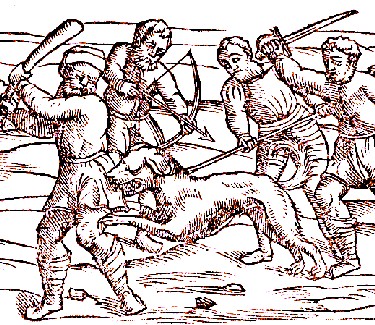
Slaying a Mad Dog, From Acera de la Materia Medicina, by
Pedanius Dioscordes (1566)
Period surgeons knew that cupping vessels placed on a wound had drawing power. Thus it makes sense to place a cupping vessel over a venemous wound because it would extract both the bad humors and the poison in the wound.
Physician Stephen Bradwell explained that when someone was bitten by a mad dog the surgeon must "Labor forthwith to draw the contagion out of the wound by cupping-glasses" in addition to using other remedies such as scarifying, leeching and 'drawing' medicines. Bradwell added that when "the wound be so small that it bleedeth not; scarife the place, and with a cupping-glasse draw out the bloud"1.
German surgeon Matthias Gottfried Purmann advised, ""In order to cure these Envenomed Wounds [from scorpions, snakes, etc.], you must first wash them very well... and when that is is sufficiently dryed in, scarify the part about the bigness of a half Crown piece, and apply to it a large Ventosa or Cupping Glass."2
Sea surgeon John Woodall recommended both internal and external treatments to "cure of wounds caused through the biting of venomous beasts (as madde dogs, scorpions, vipers, serpents, bees, fishes, wasps, hornets, swine, or other the like)"3. The internal medicines he advised were to "comfort and confirme the parts" affected while the external remedies were to "extinguish the venomous vapour (and such are [used as] cupping glasses and scarification)"4.
1 Stephen Bradwell, Helps For Suddain Accidents Endangering Life, p. 60; 2 Matthias Gottfried Purmann, Churgia Curiosa, p. 186; 3 John Woodall, the surgions mate, p. 138; 4 Woodall, p. 139
Illnesses Treated By Cupping Therapy - Tumors
Tumors,
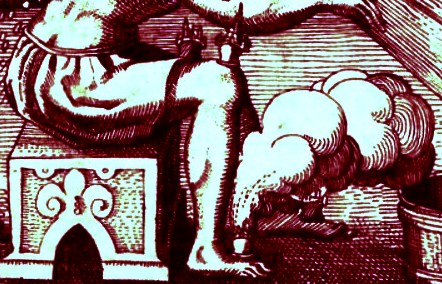
Artist: Thomas Luny
Targeted Cupping as Would Be Used to Treat Tumors, From Princely
Court Library, Waldeck Arolsen (1622)
or abnormal tissue growths in the body, were sometimes cupped according to golden age of piracy era authors. Military surgeon Richard Wiseman advises cupping repeatedly for such neoplasms, using them to draw the ill-formed flesh up. He suggests when "nature do not thrust the Tumour out as you would [want], you may further it by Cupping-glasses"1. He warns that when "the Tumour is malign, or the Crisis of a malignant Fever: ...in all such cases the Retraction [of humors] into the bloud is of very dangerous consequence: wherefore we then rather use Cupping-glasses and other Attractions to draw it out."2
French surgeon Ambroise Paré advises the use of cupping glasses for a different purpose: to try to extract whatever the tumor contains. He notes that "matter contained in the part [where the tumor is located]... is against nature, [so] it requires to be evacuate by resolving [removing] things, as cataplasmes, ointments, fomentations, cupping glasses, or by evacuation, as by scarifying, or by suppurating [pus-forming] things, as by ripening and opening the Impostume [abscess]."3
1 Richard Wiseman, Eight Chirurgicall Treatises, 3rd Edition, p. 49; 2 Wiseman, p. 7; 3 Ambroise Paré, The Workes of that Famous Chirurgion Ambrose Parey, p. 198
Illnesses Treated By Cupping Therapy - Venereal buboes
"[Cupping vessels] are also applied ...to parts possessed by a pestiferous Bubo or Carbuncle, so to draw the poison from within outwards."(Ambroise Paré, The Workes of that Famous Chirurgion Ambrose Parey, p. 443)
Richard Wiseman explains that buboes "according to the usual method of Practice, ought not to be repelled: therefore in order to the Cure [then] you are to consider the Cause". He advises that the surgeon "breath it forth by
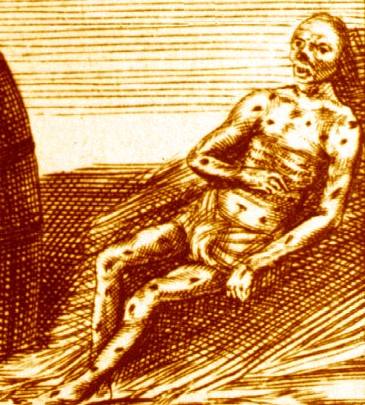
A Man With 3rd Stage Syphilis Sores
From Die Belagertund Entsetzte Venus (1689)
Discutients [medicines that disperse matter], or hasten Maturation [bring it to a head]." If it won't mature on its own, "you ought by Attraction to help it forward, either by Cupping-glasses, or by the application of four Leven [probably flour leaven], black Soap... Figs, roasted Onions &c."1 All of these last four ingredients are suggested to have healing and drawing properties.
Venereal buboes typically occurred in the groin. In his discussion of venereal diseases, Wiseman reasserts that such growths "ought to be drawn outward by Cupping glasses, and brought to Suppuration [caused to fester and release pus]." In addition, Wiseman explains that for patients with "strong Constitutions the Malignity of this Disease [syphilis] is sometimes discharged by a Bubo"2. According to this idea, an effective aid to the cure would be to make the growth suppurate, encouraging the poison out of the bubo.
Sea-surgeon John Atkins also recommended cupping for venereal buboes and likewise advised that buboes were "dangerous to repel, and should, from the Beginning, be assisted to Suppuration by Emplasticks [plasters], Cataplasms [poultices - moist, adhesive substance spread on cloth and applied to warm, moisten, or stimulate inflamed parts of the body], Cupping and the like"3. Plasters and poultices could be made with the ability to draw serum from the body, so they served a purpose similar to cupping glasses, albeit one that was more passive and slower acting than cupping itself.
1 Richard Wiseman, Eight Chirurgicall Treatises, 3rd Edition, p. 47; 2 Wiseman, p. 510; 3 John Atkins, The Navy Surgeon, p. 238-9

